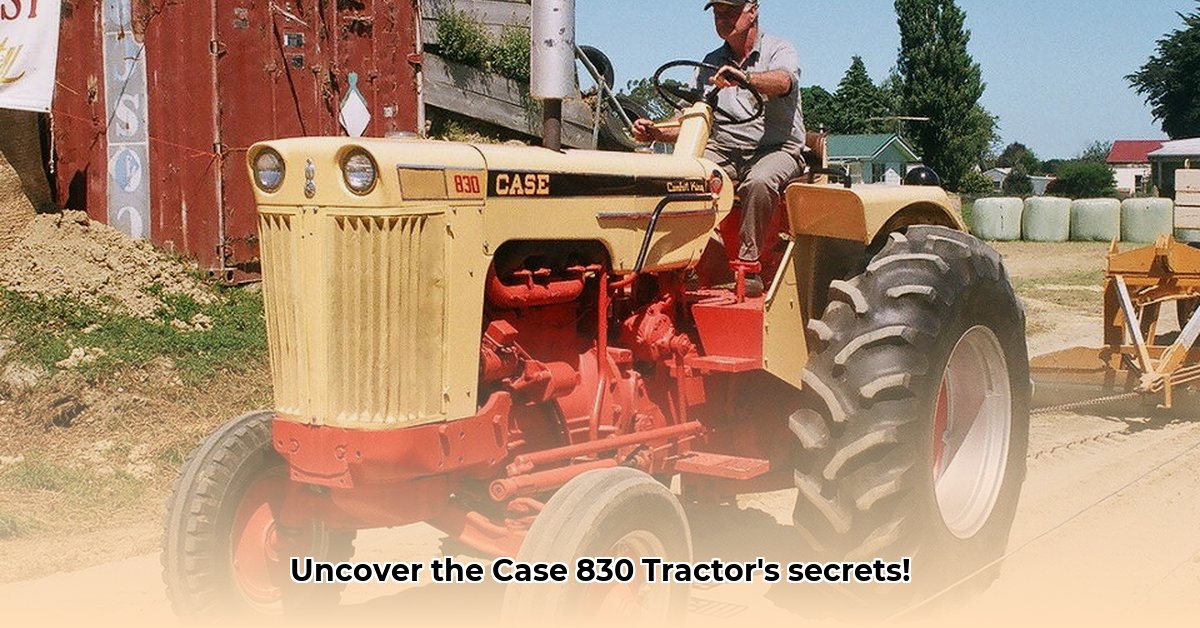
The J.I. Case 830 tractor, a steadfast icon of the 1960s farming landscape, deserves more than a passing glance. This comprehensive guide delves into its history, specifications, and the enduring appeal that continues to captivate collectors and agricultural enthusiasts alike. Whether you're a seasoned mechanic, a history buff, or simply curious about this legendary machine, you'll find the detailed information you seek within. For more Case tractor information, check out this helpful resource: Case Tractor Info.
Case 830 Tractor: A Legacy of Power and Precision
Manufactured from 1960 to 1969 in Racine, Wisconsin, the Case 830 represented a significant step forward in mid-sized agricultural machinery. Its robust design and adaptable configurations solidified its place as a favorite amongst farmers. But what exactly fueled its popularity? Let's explore the blend of engineering prowess and practicality that defined the Case 830.
Under the Hood: Power and Reliability
At the heart of the Case 830 lay its powerful engine: a 4.9-liter, four-cylinder diesel engine. This robust power plant generated approximately 73.3 horsepower (54.6 kW) – a substantial output for its era that allowed farmers to confidently tackle a broad range of tasks. From diligently plowing vast fields to efficiently operating PTO-driven equipment like hay balers, the 830 proved its versatility. Its 22-gallon fuel capacity ensured sustained operation throughout a typical workday. Farmers could further tailor the 830 to their specific needs through a choice between an 8-speed manual transmission or an automatic transmission equipped with a torque converter. This offered flexibility to match the machine's performance to the demands of the task and the operator's preference. Isn't it fascinating to consider the engineering ingenuity behind this balance of power and efficiency?
Key Specifications:
| Specification | Details | Notes |
|---|---|---|
| Engine | 4.9L, four-cylinder diesel | Known for its reliability and consistent performance. |
| Horsepower | Approximately 73.3 hp (54.6 kW) | A respectable output for its era and size. |
| Transmission | 8-speed manual or torque converter | Providing flexibility for varied farming tasks and operator preference. |
| Fuel Capacity | 22 gallons | Sufficient for a full day's work under typical conditions. |
| PTO | 540/1000 RPM | Enabling operation of a wide range of PTO-driven implements. |
Configurations and Versatility: A Tractor for Every Farm
The Case 830 wasn't a one-size-fits-all machine. Recognizing the diverse needs of farmers, Case offered several configurations. Row-crop versions were optimized for navigating between rows of crops, while “Western Special” models were designed to handle the unique challenges of western terrains. The availability of optional front-end loaders further expanded the 830’s capabilities, transforming it into a multi-purpose workhorse adept at materials handling and a variety of tasks beyond traditional tillage. This adaptability contributed significantly to the 830's broad appeal, making it a practical and versatile investment for numerous farmers across diverse agricultural settings. How did this versatility impact farming practices of the time?
A Piece of Agricultural History: The Enduring Legacy of the Case 830
Today, the Case 830 transcends its role as a mere vintage tractor; it stands as a symbol of a pivotal era in American agriculture. For collectors and enthusiasts of agricultural history, restoring a well-preserved Case 830 is a rewarding endeavor, a tangible connection to the past and a testament to enduring craftsmanship. Yet, maintaining these older machines demands specialized skills and a commitment to diligent upkeep. Sourcing parts can be a challenge, requiring persistence and resourceful networking within the vintage tractor community. But the immense pride and fulfillment derived from resurrecting a piece of this rich history are undeniably significant.
Restoring a 1960s J.I. Case 830 Tractor: A Step-by-Step Guide
Restoring a vintage Case 830 is a comprehensive project demanding patience, meticulous attention to detail, and a deep appreciation for classic machinery. This detailed guide provides a structured approach to the restoration process, breaking down the tasks involved into manageable steps.
Assessment and Documentation: Begin with a thorough assessment of the tractor's condition. Document everything, including rust, missing parts, engine condition, and overall mechanical integrity using photographs and detailed notes. This detailed assessment forms the foundation for a successful restoration.
Disassembly: Carefully disassemble the tractor, meticulously labeling each part for accurate reassembly. This systematic approach ensures that no component is misplaced or forgotten. Proper organization is incredibly important.
Engine Restoration: The engine is the heart of the restoration. A complete rebuild or replacement might be necessary, depending on its condition. Key components such as pistons, rings, gaskets, and bearings often require attention. Thorough cleaning or replacement of the fuel system is also essential.
Transmission and Hydraulic System Repair: The Case 830's likely Draft-O-Matic transmission and hydraulic system necessitate equally careful attention. Inspect each component thoroughly for signs of wear and tear, as these parts can be costly and difficult to source.
Bodywork and Paint: Once the mechanical systems are restored, focus on cosmetic restoration. Repair rust, replace damaged panels, and prepare the tractor for repainting. Accurate color matching is crucial for maintaining historical accuracy.
Reassembly and Testing: Reassemble the tractor systematically, following the reverse order of disassembly. Thoroughly test all systems to ensure proper functioning after reassembly. Regular maintenance is key to maintaining the tractor's integrity and longevity.
Resourceful Part Sourcing: Obtaining replacement parts for a 1960s tractor can be a significant challenge. Networking with fellow Case 830 enthusiasts in online forums and vintage tractor clubs is highly recommended. This collective knowledge and support greatly enhances the restoration project.
Three Pivotal Points Regarding the Case 830 Tractor:
- Its robust 4.9-liter diesel engine provided significant power for its era.
- The availability of multiple configurations (row-crop, Western Special) catered to diverse farming needs.
- The tractor's enduring legacy continues to inspire restoration projects and captivates collectors.
This detailed guide provides a comprehensive overview of the J.I. Case 830 tractor, blending technical specifications with engaging historical context. By understanding its history, appreciating its design, and embracing the challenges of restoration, we can continue to celebrate this lasting piece of agricultural heritage.